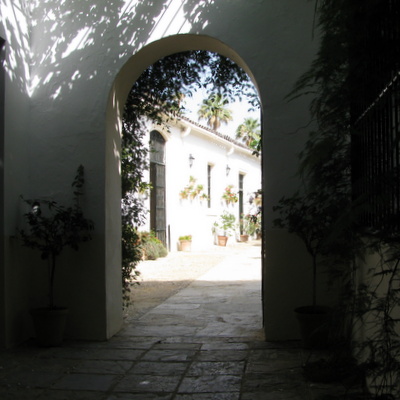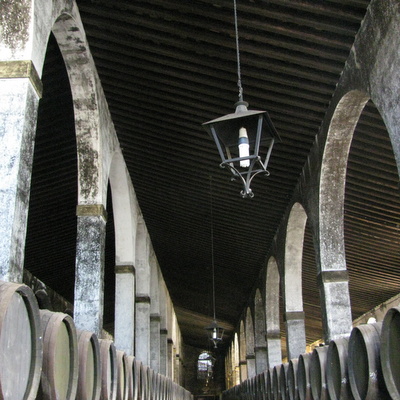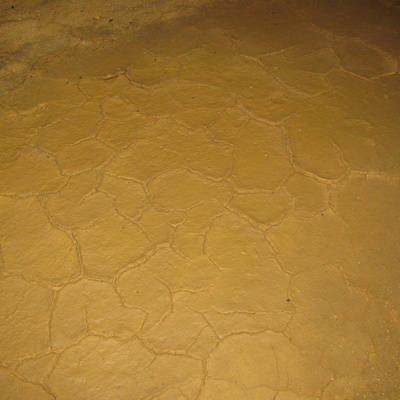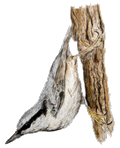
- Sherry Wine:
- Production
- Classification
- Cities & Bodegas
- Tastings
- Analogues
- Authors & Contacts
- Ðóññêèé ñàéò
The Jerez Region municipalities
Sherry Bodegas
Olga Nikandrova and Denis Shumakov.
Sherry production is a geographically distributed process. The base wine is produced on a winery situated near vineyards. Sherry maturation is done in the towns of the Maturation Zone, in bodegas — buildings specially created for this maturation — which have their own microclimate and special rules for its sustaining.

Patio of Bodegas
Bodegas González Byass — Tio Pepe
The word “bodega” has a common and rather distant relative with such heartwarming words as “boutique” and “apothecary”. Their ancestor is a Greek word ἀποθήκη, meaning “storehouse” or “depository”. In modern Spanish the word “bodega” can denote a wine house in general or a certain wine cellar, a tavern or some other objects related to trading or storing goods, but not to wine immediately.
Practically the same is true for the Jerez Region. “Bodega” may be a whole and big wine house. “Bodega” may be a small “dispenser point”. And “bodega” may be a building where sherry is matured. The only difference from other wine bodegas is that sherry bodegas are never dug below ground — their floors are always at street level.
All main requirements to the bodega are connected with the necessity to optimize the microclimate of the building for biological ageing of sherry. In other words, the bodega’s microclimate must be good for sustaining flor’s activity. It is not exactly that microclimate is absolutely unimportant for oxidative ageing — but if this microclimate suits biological ageing it would do for the oxidative one as well.

Inside one of Emilio Lustau’s bodegas
You will recall that for its normal activity flor needs temperature of about 18°C and around 70% humidity. The bodega as such works on the creation of such conditions at least for some of its barrels. It is noteworthy though that the climate in the Jerez Region is on average just like this — annual mean temperature in Sanlúcar de Barrameda, for example, +18°C, and average humidity — 74,25%. The aim of bodega is to protect sherry from fluctuations of temperature and humidity. First of all — in winter (from the cold, in the Andulusian sense of this word) and in summer (from the heat and dryness).
A range of different solutions can be used to smooth out fluctuations in microclimate, but we’ll focus only on more or less standard (while not at all mandatory) ones of them.
Bodegas are normally built large and high (up to 12 m high and 33 m wide — the larger the system, the more difficult it is to disrupt), with thick white walls (about 60 cm — thermos properties of such walls are very high) and tiled roofs. Bodegas are often positioned advantageously against the sun (taking the strongest “sunstroke” on the white walls) and the winds (so that the wet wind from the Atlantics would blow into windows and doors, and the dry one from Africa — would not). Windows in bodegas are usually small, they are situated high above the ground and are often covered with thick fabric (as well as doors) — to protect the insides of a bodega from dust and the sun. The floor in a bodega is often covered with Albero sand — it is regularly watered keeping humidity high.

Sand in one of Emilio Lustau’s bodegas
But even strict observation of the mentioned principles leaves space for maneuver while constructing and equipping a particular building thus allowing to build very different bodegas. Many sherry bodegas are most interesting examples of industrial architecture and places of tourist attraction or professional interest. Bodegas’ architecture, interior and equipment are worth of a separate study, for which we are not ready at the moment.
Therefore we shall finish the theoretical part with three remarks.
Remark one — all bodegas are different, and they all influence the sherry that is matured in them differently. In fact, the location of a bodega, its architecture and conditions inside are all parts of the construction set which determines the drink in the end.
Remark two. A bodega (a certain wine house) may have several bodegas (buildings where wine is matured). Sometimes, this may be reflected in the name of the wine house — it would literally say bodegas (e.g. Bodegas San Sebastián).
Remark three. An official one. We nearly forgot to mention. All sherry bodegas are classified according their functionality and can be the following types.
Maturing and Shipping Bodegas (Bodegas de Crianza y Expedición) are companies located in the towns of the Ageing and Maturing Zone which deal with ageing, shipping and selling sherry wine.
Ageing and Maturing Bodegas (Bodegas de Crianza y Almacenado) or Almacenistas are companies (usually small) which only mature and store sherry but do not place their product on the retail market. Almacenistas sell their sherry (without bottling it) to other companies (to shipping bodegas, for example) which bottle and sell it, usually mentioning the name of the almacenista on the label.
Production Zone Bodegas (Bodegas de Zona de Producción) are companies located within the Production Zone and producing wine for Maturing and Shipping Bodegas. Thereon it is matured and becomes sherry. Production Bodegas can mature and sell wine on their own — but then it cannot be named sherry. Exception is made for Moscatel wine made from raisined grapes and matured in Chipiona or Chiclana de la Frontera — it is included into the sherry line.
Warning!
This site can contain information about drinks excessive consumption of which may cause harm to health and is unadvisable for people who didn’t come of age.
Share Sherry
- Sherry.wine, FEDEJEREZ
- Copa Jerez, Sherry Week
- Sherry Notes, Jerez de Cine
- Los Generosos, Criadera
- Jerez-Xeres-Sherry
- Los Vinos de Jerez
Articles
- There are more articles in Russian than in English in this website. Sorry :(
Reviews
- To our great regret, we didn’t have time to translate tasting and traveling notes into English. But, if you want, you can see them in Russian.

